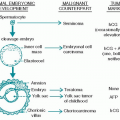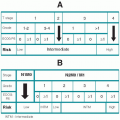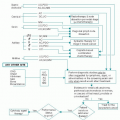I. EPIDEMIOLOGY AND ETIOLOGY
A. Incidence. Malignant primary brain tumors represent 2% (17,000 cases) of all cancers and 2.5% (10,000 cases) of cancer deaths annually in the United States (
Table 14.1). The male-to-female ratio is 3:2. The incidence peaks at 5 to 10 years of age and again at 50 to 55 years of age. Brain cancers are the most common solid tumors in children, and childhood brain cancers are discussed further in
Chapter 18, “Brain Tumors.”
B. Etiology
1. Environmental factors, such as tobacco, alcohol, and diet, have not been associated with primary central nervous system (CNS) tumors. Exposure to ionizing radiation, however, can induce the formation of meningiomas, nerve sheath tumors, sarcomas, and astrocytomas. Exposure to electromagnetic radiation, including cell phones and computer terminals, does not cause brain tumors. Occupational exposure to vinyl chlorides may be a risk factor for astrocytomas; animal studies have shown that exposure to N-nitroso compounds, aromatic hydrocarbons, triazenes, and hydrazines increases the risk for astrocytoma formation, but it is not clear whether these compounds play a role in human tumor formation. Recent data suggest that individuals with atopy or chronic asthma may be at lower risk of glioma.
2. Hereditary neurocutaneous syndromes
a. Neurofibromatosis I is a dominantly inherited condition of multiple neurofibromas, café-au-lait spots, axillary freckling, and Lisch nodules of the iris that confers an increased risk for optic glioma, intracranial astrocytoma, neurofibrosarcoma, neural crest-derived tumors (glomus tumor, pheochromocytoma), embryonal tumors, leukemia, and Wilms tumor. The gene for this disorder is on chromosome 17q11, and its product, neurofibromin, is a tumor suppressor that regulates the Ras pathway, which transmits mitogenic signals to the nucleus.
b. Neurofibromatosis II is a condition of multiple schwannomas, especially vestibular schwannomas, that is also associated with an increased risk for ependymoma and meningioma. The gene for this disorder is located on chromosome 22q12, and its product, merlin, encodes a member of the ezrin-radixin-moesin (ERM) family of membrane and cytoskeletal linker proteins thought to be important for cell motility and adhesion.
c. Tuberous sclerosis (Bourneville disease) is a dominantly transmitted disorder characterized by the development of hamartomas, including subependymal nodules and cerebral cortical tubers that have abnormal cortical architecture and can be associated with mental retardation, epilepsy, and behavioral disturbances such as autism. Hamartomatous lesions of other organ systems include facial angiofibromas, forehead plaques, shagreen patches, cardiac rhabdomyomas, and renal angiomyolipomas and cysts. This disorder is associated with the formation of subependymal giant-cell astrocytomas. Two responsible tumor-suppressor genes,
TSC-1 (chromosome 9q34) and
TSC-2 (chromosome 16p13), have been identified.
d. Nevoid basal cell carcinoma syndrome (Gorlin syndrome) is a dominantly inherited syndrome of multiple basal cell carcinomas that may be associated with medulloblastoma, meningioma, craniopharyngioma, and some systemic tumors (ovarian tumors, cardiac fibroma, maxillary fibrosarcoma, adrenal cortical adenoma, rhabdomyosarcoma, seminoma). Other features include jaw cysts, palmar and plantar pits, and spine and rib anomalies. The loss of a tumor-suppressor gene on chromosome 9q22 is responsible for this disorder. Its gene product, PTCH, is the human homologue of the Drosophila patched gene, part of the hedgehog signaling pathway, which is important in embryonic patterning and cell fate.
e. Neurocutaneous melanosis is a developmental rather than inherited condition of large, hairy, pigmented benign nevi of the skin associated with infiltration of the meninges by melanin-containing cells. Although the pigmented lesions of the skin remain benign, the pigmented cells in the meninges often undergo malignant transformation with neural invasion, resulting in primary CNS melanoma.
3. Hereditary cancer syndromes
a. von Hippel-Lindau disease is a dominantly transmitted disorder characterized by hemangioblastomas of the retina, cerebellum, and, less commonly, spinal cord. Other associated tumors include renal carcinoma, pheochromocytoma, islet cell tumors, endolymphatic sac tumors, and benign renal, pancreatic, and epididymal cysts. The disorder is due to the loss of a tumor-suppressor gene on chromosome 3p25-26. This loss results in the overexpression of vascular endothelial growth factor (VEGF) and erythropoietin, which are normally induced by hypoxia.
b. Turcot syndrome is a rare autosomal dominant or recessive familial syndrome associated with colon cancer, glioblastoma, and medulloblastoma. It is due to a germline mutation of the APC gene on chromosome 5q21, or germline mutations of genes governing the DNA replication mechanism including the hMLH-1 or hPMS-2 genes, both of which encode proteins responsible for DNA mismatch repair.
c. Li-Fraumeni syndrome is a clinical syndrome of familial breast cancer, sarcomas, leukemia, and primary brain tumors that is associated with germ line p53 (chromosome 17) mutations.
4. Immune suppression. Transplant recipients and patients with acquired immunodeficiency syndrome (AIDS) have a markedly increased risk for primary CNS lymphoma.







